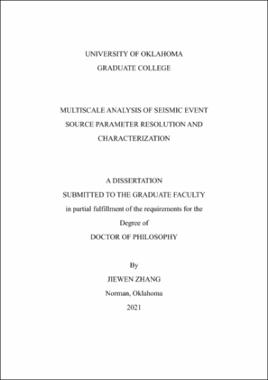| dc.description.abstract | Earthquake source parameters such as stress drop help us understand the underlying physics of tectonic stress loading and releasing associated with the occurrence of earthquakes, and the influence of human activity on the underground stress status whether in the resource exploration area or in the urban area. In my Ph.D. research, I aim at studying regional and local datasets in different tectonic settings to understand the relationship between stress drop and some other source parameters and those physical processes.
To understand how the stress drop variability helps interpret the fault behaviors related to a large earthquake, I examine the source parameters including stress drop, corner frequency and seismic moment of thousands of small earthquakes along the San Andreas fault (SAF) at the Parkfield area in California, USA. In this research, I first try to understand the uncertainties of these source parameters among different studies and find that it is important to reasonably organize data spatially and temporally to account for the heterogeneity of material properties, such as attenuation and shear wave velocity variations. These results show that proper corrections significantly reduce the scatter in stress drop estimations, and weaken depth/magnitude dependence. The results also suggest that frequency bandwidth has strong influence on corner frequency estimations, insufficient bandwidth may cause systematic underestimation and increased stress drop scatter. The well-resolved stress drops are independent of magnitude within a resolvable corner frequency range, suggesting that these earthquakes follow self-similar rupture processes. The results exhibit complex stable spatial patterns with no clear correlation with slip partition or slip distributions of the 2004 M6 earthquake. In some regions with a sufficient number of earthquakes, I resolve robust temporal variations that indicate stress drop decrease following the 2004 earthquake, and gradual recovery. These temporal variations do not affect the long-term stress drop spatial variations, suggesting local material properties may control the spatial heterogeneity of stress drop.
To further analyze the source of the uncertainties in the stress drop estimation, I compare the Parkfield small earthquake corner frequency and stress drop estimates using different methods, parameter selection and datasets. A new method based on global optimization and spectral decomposition is proposed and compared to published methods and results. It is found that with sufficient bandwidth, different methods can obtain similar results. When bandwidth is insufficient, corner frequencies above the resolution limit can have very different results depending on different methods. Corner frequencies that are within the resolution limits tend to be similar with different methods. These results suggest that stress drop interpretations should carefully consider the resolution limit for given dataset, and consistency across multiple methods is important to ensure the source parameters are well resolved. Results in this study may help understand the strong variability of stress drop and corner frequency estimates from different studies when they are compiled for comparison.
Finally, I apply the knowledge and practice to microseismic events that occurred during Hydraulic-Fracturing (HF) to examine the similarity and differences in source parameter patterns between earthquakes occurring on faults and microseismic events occurring on hydraulic fractures. To fulfill this, I invert for a 1D velocity model based on sonic logs and perforation shots. Then, I build a microseismic event catalog by detecting microseismic events from raw microseismic data using Short-Time Average and Long-Time Average Ratio (STA/LTA) method, and locating these events using the inverted 1D velocity model. Using spectra with high signal-to-noise ratio, I obtain source parameters (corner frequency, source radius, and relative stress change) of the detected microseismic events using the new developed method in previous chapters. The high-resolution location and source parameters exhibit spatial migration of microseismic events following fluid diffusion curve, and gradual changes of source parameters with distance from the fracturing point. These observations suggest an influence of fluid on event occurrence and source processes. These microseismic events have relative stress changes increasing with magnitude, suggesting they are non-self-similar, which is different from the natural earthquakes studied in the Parkfield area as well as some other previous research. S/P amplitude ratio analysis of these microseismic events suggests these events are mostly tensile failure and mixed tensile/shear failure events, differing from shear-failure dominated natural earthquakes. My results suggest that microseismic events occurring on hydraulic fractures can have different source processes from natural earthquakes occurring on pre-existing faults. | en_US |

